[ad_1]
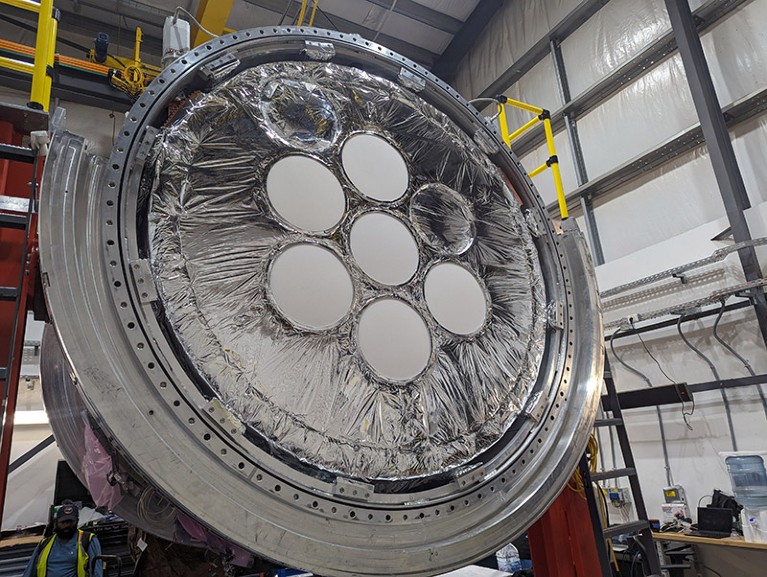
The entrance of the Simons Observatory’s Massive Aperture Telescope Receiver, the most important receiver for observing the cosmic microwave background constructed up to now.Credit score: Mark Devlin/College of Pennsylvania
Cosmologists are making ready to forged their sharpest-ever eyes on the early Universe. From an altitude of 5,300 metres on Cerro Toco, in northern Chile’s Atacama Desert, the Simons Observatory will map the cosmic microwave background (CMB) — generally known as the afterglow of the Massive Bang — with a sensitivity as much as ten occasions better than that of the earlier gold commonplace, Europe’s Planck house probe.
“Will probably be the very best view of the CMB that we’ve ever had,” says Jo Dunkley, a cosmologist at Princeton College in New Jersey and one of many main researchers within the observatory’s staff. Development of the US$109.5-million observatory is because of be accomplished in a matter of weeks.
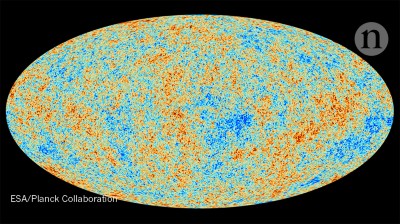
Massive Bang telescope finale marks finish of an period in cosmology
One of many venture’s objectives is to search out fingerprints left within the CMB by gravitational waves that originated from the Massive Bang itself. These would supply the primary incontrovertible proof for cosmic inflation, a short second through which enlargement is assumed to have proceeded at an exponential price. Throughout that point, quantum fluctuations on a microscopic scale are thought to have seeded the Universe with what turned its large-scale construction — together with the present distribution of clusters of galaxies throughout house.
The scientific collaboration is led by 5 US universities and the Lawrence Berkeley Nationwide Laboratory in Berkeley, California. The venture is known as after Jim Simons, a mathematician, billionaire hedge-fund investor and philanthropist, and his spouse Marilyn. The Simons Basis in New York Metropolis contributed grants of round $90 million to construct the observatory.
As soon as development is full, engineers will start the months-long processof fine-tuning and testing the observatory’s devices earlier than its science programme can absolutely start.
Indicators of inflation
The Simons Observatory is an array of 4 telescopes. Three are equivalent 0.4-metre small aperture telescopes (SATs) and one is the 6-metre Massive Aperture Telescope (LAT). Collectively, they may map minuscule variations within the temperature of the CMB from one patch of the sky to the subsequent, in addition to the CMB’s polarization, which is a preferential course through which the radiation’s electrical fields wiggle because the microwaves propagate by way of house.
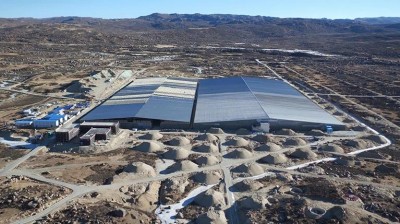
China’s mountain observatory begins hunt for origins of cosmic rays
The three SATs will focus on a patch masking 20% of the southern sky. The goal is for them to review large-scale swirls — spanning an space a number of occasions the obvious dimension of the Moon within the sky — within the polarization area of the CMB. (Polarization maps appear like arrays of sticks, and the orientations of the sticks can kind particular swirling patterns known as vortices.) It’s right here that the indicators of cosmic inflation, often known as B-mode patterns, are anticipated to point out up.
Many cosmologists see inflation as probably the most believable mechanism for the method that gave the Universe its construction, attributable to an vitality area known as the inflaton. The character and properties of the inflaton are mysterious. Many theories have been proposed, predicting gravitational-wave signatures of a variety of intensities.
It’s due to this fact not assured that the sign, if it exists, is robust sufficient for the Simons Observatory to see it, says Suzanne Staggs, one other Princeton cosmologist who’s the observatory’s co-director. “However oh my gosh — in the event that they had been proper there, it might be wonderful.”
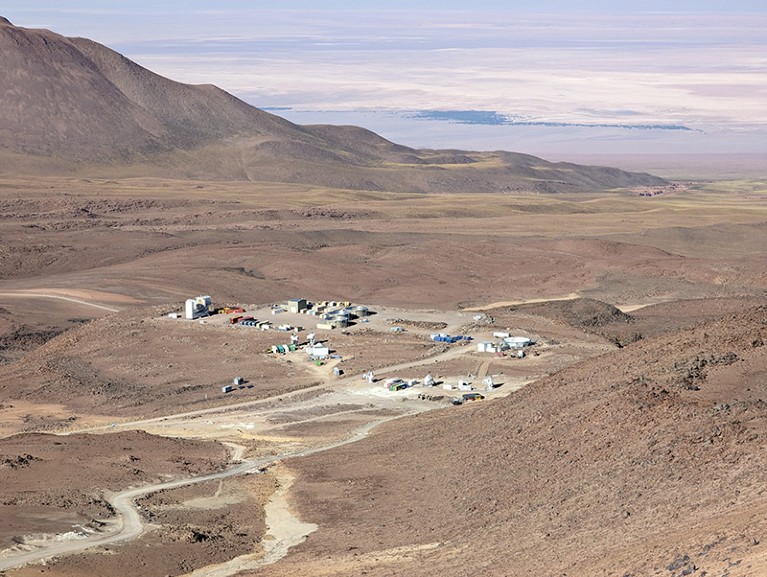
The Simons Observatory web site photographed from the facet of Cerro Toco within the Atacama Desert, Chile.Credit score: Mark Devlin/College of Pennsylvania
The recognized physics of quantum fields means that the signatures ought to be inside theSimons Observatory’s sensitivity vary, or near it, says Marc Kamionkowski, a theoretical astrophysicist at Johns Hopkins College in Baltimore, Maryland, who was among the many first researchers to foretell the existence of B-mode patterns in 19971,2.
Whereas the SATs give attention to a comparatively small space, the LAT will map 40% of the sky, at a lot finer decision, and document temperature fluctuations within the CMB, in addition to the CMB’s polarization. Cosmologists engaged on Planck and different previous CMB tasks have been in a position to extract troves of data by plotting the depth of these temperature fluctuations in opposition to the realm of sky that they span. Such graphs enabled cosmologists to provide exact estimates of each the Universe’s age (13.8 billion years) and its composition (solely round 4% of which is extraordinary matter).
The LAT information may assist researchers to detect indicators of cosmic inflation in low-resolution polarization maps made by the smaller telescopes. Particularly, they are going to be essential for separating that sample from spurious indicators produced by results corresponding to mud within the Milky Method, explains Mark Devlin, a cosmologist on the College of Pennsylvania in Philadelphia who’s co-director of the observatory. The experiment will probably be six occasions extra delicate to the polarization patterns than any earlier makes an attempt3 to measure them.
Exploring unknowns
Nonetheless, looking for indicators of inflation is barely one of many venture’s objectives: the Simons staff plans to get far more science from the observatory’s high-resolution map of the CMB. It’ll allow researchers not solely to visualise the Universe at an early age, but additionally to review how its primordial radiation was affected through the 13.8 billion years it spent travelling in house, earlier than it obtained to Earth.
Particularly, the CMB is diverted by the gravity of huge clumps of galaxies and darkish matter — a phenomenon often known as gravitational lensing — and this may be exploited to provide 3D maps of these clusters. Devlin, Staggs and their collaborators pioneered this system with an earlier high-precision CMB venture known as the Atacama Cosmology Telescope, which was in operation from 2007 to 2022, additionally at Cerro Toco, and has but to publish its ultimate outcomes. The Simons staff will reconstruct the gravitational lensing skilled by the CMB, and decide how a lot of that is because of the Universe’s neutrinos. This may allow them to calculate the mass of those particles, which continues to be unknown. “It’s a assured sign,” says Brian Keating, an astrophysicist on the College of California, San Diego, who’s the venture’s principal investigator.
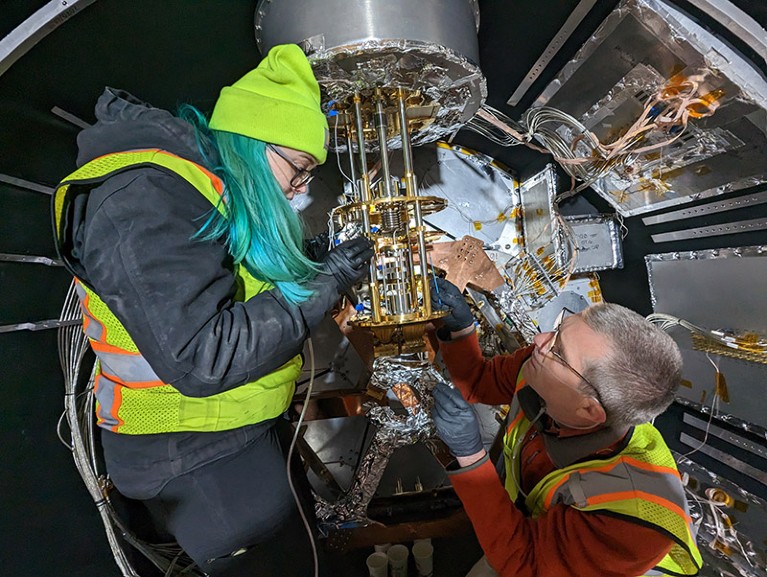
Physicists Anna Kofman and Simon Dicker on the College of Pennsylvania in Philadelphia work on the dilution fridge contained in the Massive Aperture Telescope Receiver.Credit score: Mark Devlin/College of Pennsylvania
As a result of the LAT will probably be scanning the identical areas of sky repeatedly over its lifetime, it can additionally have the ability to observe the movement of asteroids within the Photo voltaic System and monitor energetic black holes on the centres of different galaxies — and the way their output modifications over time. “We’re going to have the ability to observe 20,000 or extra energetic galactic nuclei, that are, we predict, supermassive black holes with jets,” Dunkley says.
Bold follow-up
The observatory could have two runs, every lasting about 4 years, with a deliberate $53-million improve in between. An much more bold venture known as CMB-S4, to be led by the US Division of Vitality and the Nationwide Science Basis, is deliberate as a follow-up, with observations starting within the mid-2030s. With telescopes at each Cerro Toco and the South Pole, the $800-million array will enhance sensitivity to the inflationary sign by one other issue of six.
It’s hoped that a number of the Simons Observatory’s {hardware} might be reused as a part of the CMB-S4, though the main points haven’t but been ironed out, says John Carlstrom, an astrophysicist on the College of Chicago in Illinois who’s venture scientist for the CMB-S4 collaboration.
In 2014, a staff engaged on a CMB experiment on the South Pole known as BICEP2 made a daring declare to have detected the inflationary signature, however later retracted it when it turned clear that what they had been seeing was galactic mud. Since then, direct detection of gravitational waves — coming not from the Massive Bang, however from astrophysical phenomena corresponding to pairs of black holes merging — has turn into routine. Cosmologists are excited to get one other probability to identify the primordial indicators. “We’re speaking about 13.8 billion years in the past, with vitality densities 15 orders of magnitude bigger than something we will create within the lab,” says Kamionkowski. “It’s sort of exceptional that we will even speak about this.”
[ad_2]
Supply hyperlink




